
Ben Johnson investigates how using an oscilloscope along with verified data can help you improve your diagnostic efficiency.
This month, I want to emphasise the significance of building your personal library of information and underscore why it holds such a vital role in our work. Let’s delve into the world of BMW, a company that continually provides us with an abundance of diagnostic challenges, keeping us on our toes. While this constant stream of issues keeps us engaged, what’s less than ideal is BMW’s tendency to withhold crucial data – practically none at all. Even in the realm of technical training, based on my experiences working with both BMW dealerships and specialists, there’s a conspicuous lack of information regarding what things should look like when they go awry.
Finding the problem
This week brought another typical job into my garage, an F15 X5 Hybrid. But unlike the usual suspects – BDC failures and gearbox meltdowns – this one presented a good old timing chain problem. Timing chain issues are no stranger to us, as they are a common occurrence in many workshops. However, what set this one apart was my decision to employ a scope to analyse it, capturing the waveform for my personal library. Admittedly, my library is a bit scattered and disorganised, with data strewn all over the shop, but one thing is certain – I have an abundance of invaluable data and this is the point that I am making – all of us should maintain such a collection because, as you’ll discover as you continue reading, knowledge not only saves a significant amount of time but can also pave the way for those coveted monthly bonuses we all strive for.
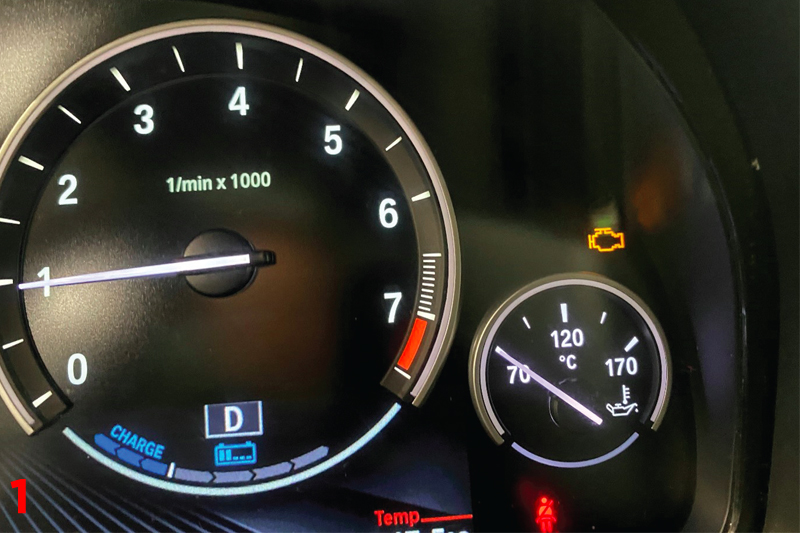
The engine sounded surprisingly smooth, but the ominous glow of the MIL (malfunction indicator light) in the corner was a silent testament that all was not right (Fig.1). The customer had thoughtfully provided us with the fault codes, most likely retrieved from a dodgy looking USB dongle that I had noticed plugged into the diagnostic socket during my attempt to connect the new Thinklink – the wireless diagnostic link from the Thinktool we recently acquired.
With the Thinktool at the helm, it swiftly retrieved the fault codes from the DME. Among them, the exhaust camshaft synchronisation with the crankshaft fault code appeared, immediately sparking my suspicion of a stretched timing chain. Yet, a dilemma arose. While I’ve scoped chains for potential stretching over many years, BMW makes it more complex due to the unique nature of each engine. Take the S series V8, for example – not a walk in the park to interpret, I assure you. The X5 I was dealing with featured the N20 engine with twin Vanos and a centrallymounted Valvetronic servo motor, easier to interpret the valve timing than a V8 however my problem was clear – I had no reference scope pattern to compare it to. A quick online search led me to an invaluable resource in Kyiv, Ukraine – Rotkee. Although they primarily deal in car diagnostic tools, their waveform repository proved to be a treasure trove. This is where I found a reference image of an N20 engine with a pristine timing chain – one free of defects such as stretching or vanos sprocket anomalies. It’s moments like these that highlight the paramount importance of having a well-organised reference library, wouldn’t you agree?
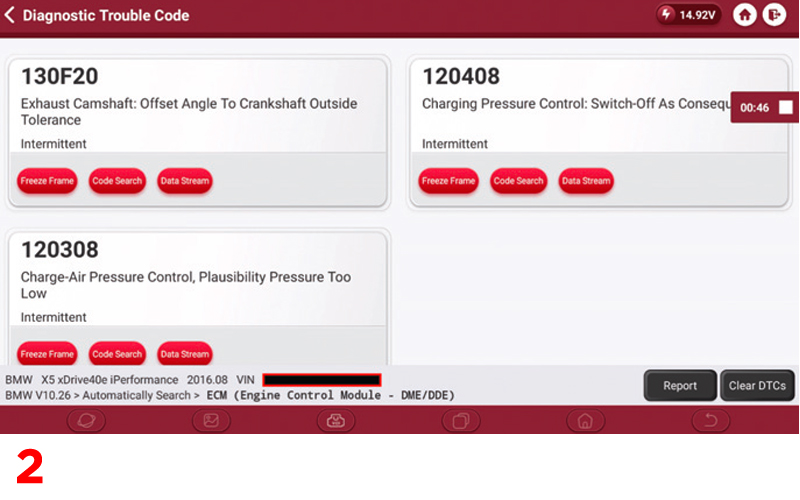
The fault code 130F20 immediately caught my attention (Fig.2), as I’ve encountered this issue countless times in N20 powerplants, and it has consistently pointed to a stretched timing chain. However, in the spirit of thoroughness, I saw an opportunity to put the Thinktool scope through its paces and create a record for my personal library. The code 120308 could be as a result of the exhaust camshaft timing fault. I may be able to confirm that link in a future follow up article. This article primarily will focus on the timing issue initially.
Connecting the Thinkscope is a breeze – simply attach the USB to the Thinktool and insert it into the scope box, connect your BNC cables, and you’re ready to go. Backpinning wasn’t an option due to the DME’s small connectors (NANO MQS) and delicate wiring, so I opted to expose a small section of outer sheathing and attach crocodile clip probes for a secure and reliable connection. After configuring channel one for the crankshaft signal and channels 2 and 3 for both camshafts, all that remained was to press “auto”, and the Thinkscope handled the waveform – a substantial timesaver compared to the antiquated AVL Di-Test, now relegated to the scrap heap.
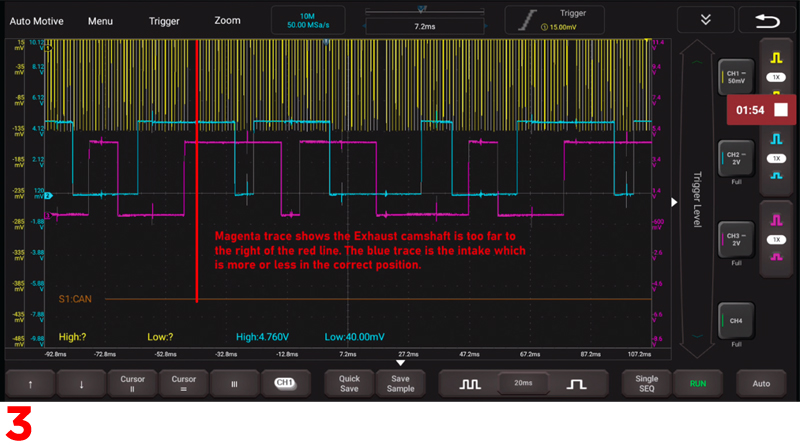
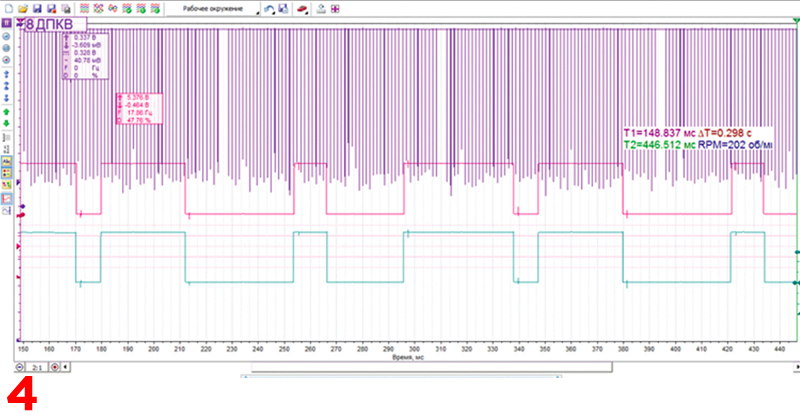
The scope revealed a vivid image (Fig.3), making it evident that the exhaust camshaft was out of alignment with respect to TDC (indicated by the yellow trace) on the crankshaft. However, here’s the catch: in certain BMW engines, the valve overlap you see in the magenta and blue traces can appear deceptively similar, even in engines without any faults. The N20, on the other hand, offers a more straightforward and distinct pattern. It comprises exhaust and intake cams with no overlap, but once Vanos and Valvetronic come into play, things can change. Perhaps, on a future occasion, I should create a waveform to record the independent advancement and retardation of the camshafts. In its current state, the engine operates under no load, and the variable valve timing should be in a neutral position – or at least, it should be. To gain a better perspective, take a look at another waveform I found on Rotkee’s website (Fig.4).
Tackling the problem
To address this issue, my first step was to tackle the laborious task of removing the cam cover, a challenge exacerbated by the imposing presence of the X5 wrapped around me. With the cam cover out of the way, I could then directly access the exhaust camshaft to inspect why it was not synchronised. Employing a spanner, I turned the camshaft and scrutinised the Vanos sprocket – to my satisfaction, there was no play or slackness, effectively ruling out any mechanical problems. However, I strongly recommended replacing this sprocket, along with the intake sprocket, as using a new chain with old sprockets is a practice best avoided. Furthermore, there were no fault codes reported for the Vanos solenoids, which, on the N20, have established themselves as dependable, unlike the earlier N43’s long finger-type solenoids.
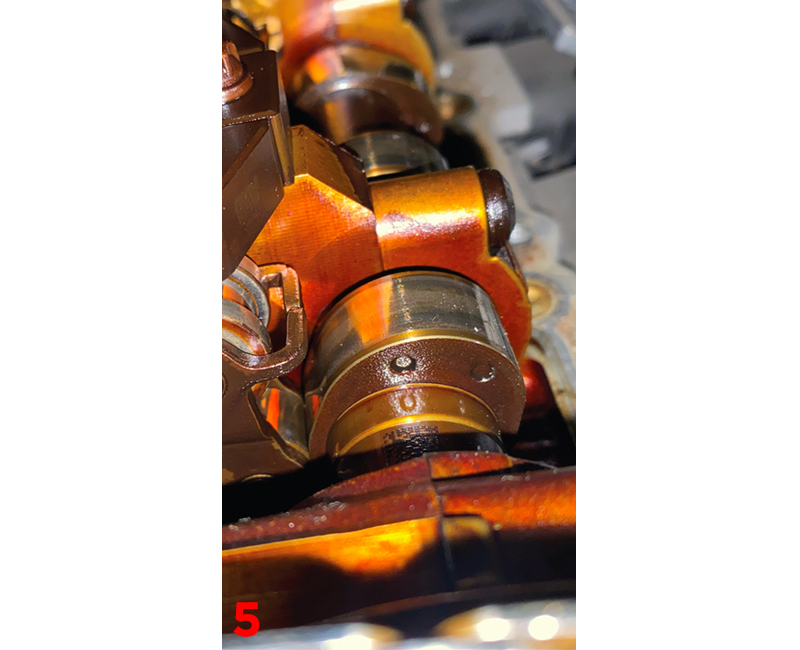
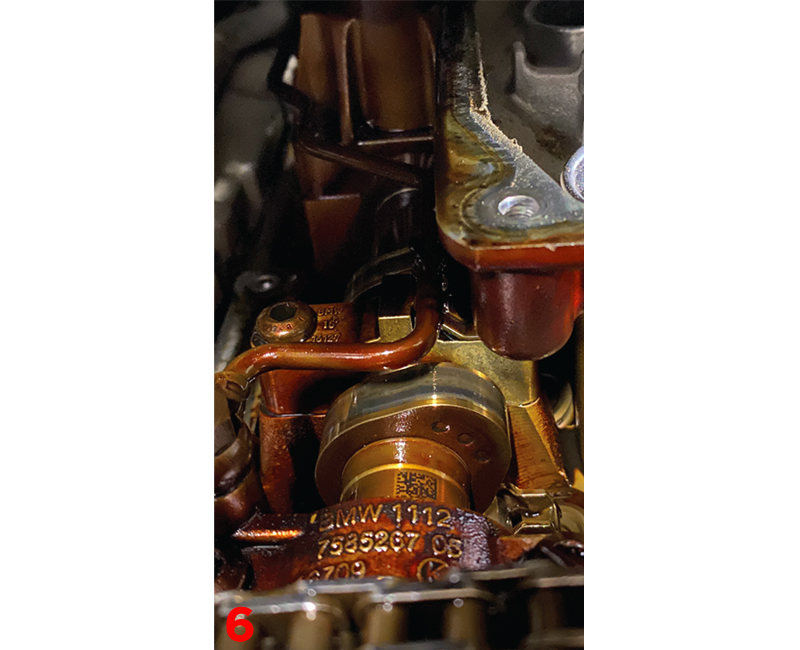
Upon closer inspection, the intake camshaft appeared to be in good condition, visibly aligned at the 12 o’clock position (Fig.5). However, the exhaust camshaft, as indicated by the earlier scope trace, was noticeably out of sync, resembling a position closer to 7 minutes past the hour, if that description makes sense (Fig.6).
For many years, BMW engines have embraced keyless design, lacking dowels or woodruff keys, even on the crankshaft. This feature elevates the importance of precise timing. Once the Vanos sprockets are removed and then replaced, and the timing chain is reassembled, the use of camshaft phase wheel locking tools becomes indispensable to ensure that cam timing is impeccably aligned. The phase wheels cannot be aligned without a specialised tool. Additionally, this tool proves handy as a visual guide to gauge the extent of timing misalignment on the exhaust camshaft before repair.
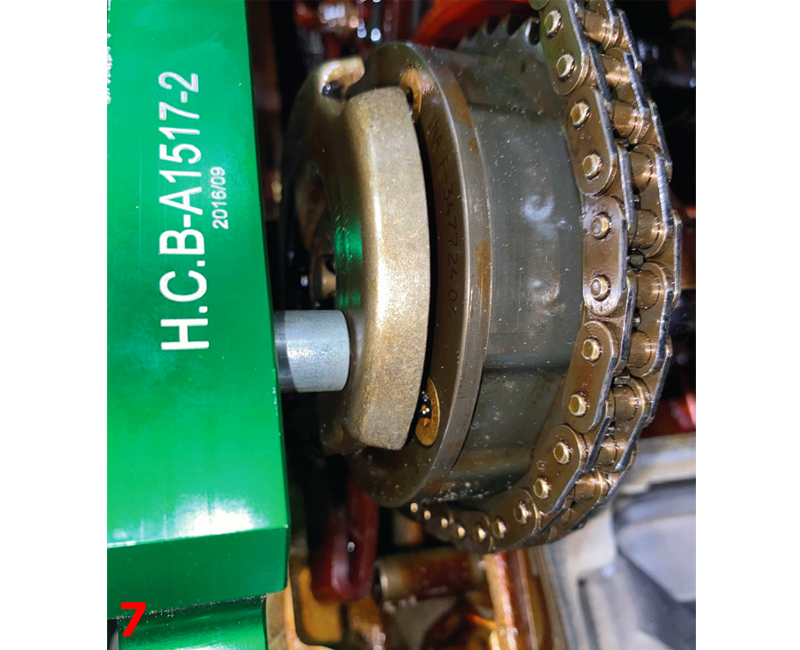
You may have noticed that I refrained from locking the crankshaft during this repair process. I found no need to invest additional time in this step, given the challenging location of the locking pin orifice, which would have consumed an unreasonable amount of time to remove the blanking pin and secure the engine. The compelling evidence lay in the absence of intake camshaft/crankshaft correlation fault codes, indicating that the crank timing was essentially correct and the intake camshaft timing also correct. In a situation where time was of the essence – as the customer surprisingly desired the car’s swift return – this decision was pivotal (Fig.7).
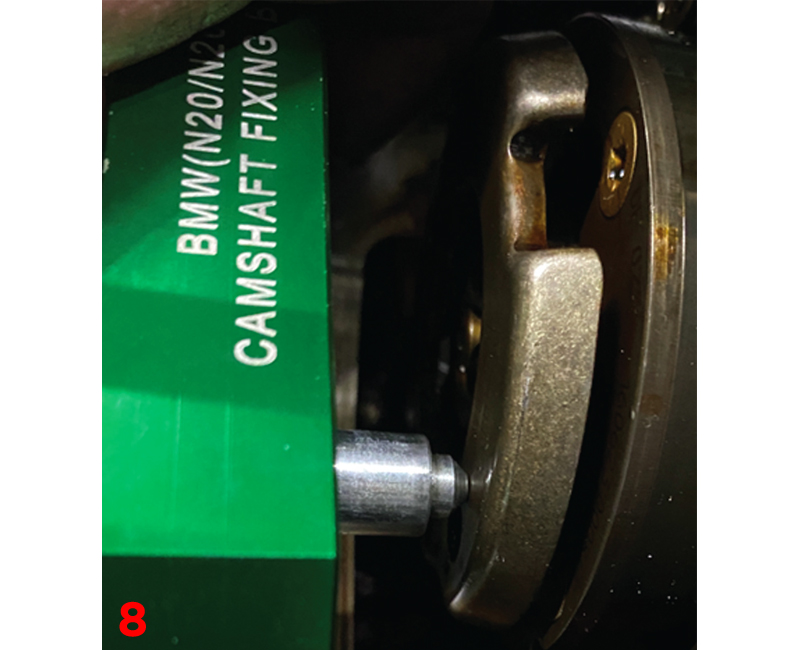
The replacement of the timing gear is scheduled for completion next week. However, on that very day, I had to ensure the car was ready to go back to the customer. Such is the relentless pace and pressure of a fault finder’s daily life.
I hold a strong conviction that a new chain and a set of Vanos adjusters (sprockets) will effectively resolve this problem. This case study serves as a reminder of the pivotal role that your own reference library plays. This job, from reading fault codes to setting up the scope, researching online to interpret values, and the final step of physically removing the cam cover for visual confirmation, took approximately three hours. It’s essential to remember that when faced with a potential stretched chain, a swift and precise diagnosis can save a significant amount of time without needing to loosen a single bolt or getting one’s hands excessively dirty. With the right library of data and a strategic approach, we can all work more intelligently, ultimately saving time for both ourselves and the customer while contributing to reaching that monthly bonus sooner. Until next time, keep learning and keep improving every day. I hope that this article has inspired you to begin building your very own reference library because it will be the best decision that you make as you continue down the path of self development.









